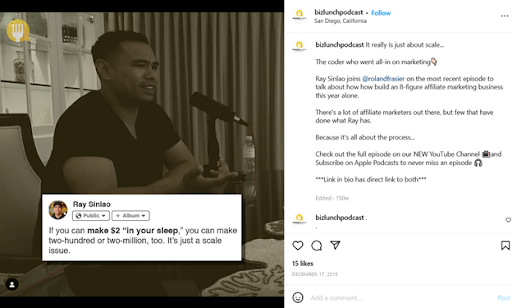Podcasts have become increasingly popular in the past few years since Google made them playable in search results. Their popularity is more than obvious, given that Spotify is home to 4.7 million of them at the time of this writing. Apple Podcasts hosts 2,503,247 podcasts as of November 2022, while iTunes has 550,000 active podcasts.
That tells you one essential thing; you don’t want your podcast to become just an insignificant drop of water in the ocean of active podcasts. You need to stand out from the crowd and get more listeners.
That’s why you need an effective SEO strategy: a strategy helps people understand why they should listen to your podcast, and search engines understand how to rank it correctly.
In this article, we’ll go through a 10-step checklist that will help you dominate on Google. We will analyze plenty of examples along the way to see what lessons you can learn.
But first…
What is podcast SEO?
Podcast SEO is a type of audio SEO, along with webinars or other audio content. Therefore, podcast SEO is a group of techniques that help podcasts’ content rank better on Google.
Some of these techniques are the same as with written content (i.e., using relevant keywords and optimizing the podcast description).
However, some tactics may take you completely by surprise. But we’ll discuss them below.
Pro tip: Podcasts help you rank higher on search engines than other audio content types. The podcast box in Google SERPs related to people’s queries confirms that; after all, you don’t see a webinar box on Google SERPs.
As such, podcasts aren’t mingled with other results – they’re always visible.
How to optimize your SEO and get more traffic
Optimizing your podcast SEO should be your main concern if you want more traffic. Below, I’ll elaborate on 10 different techniques you can employ with a few examples.
1. Create a dedicated web page
If you don’t already have a page for your podcast, you need to create one as soon as possible because people can:
- Find your show faster: That improves user experience, a relevant variable in SEO optimization.
- Gather on your page: As such, Google can assess your visitors better because they’re all in one place (your webpage).
Besides, you can focus all your efforts on optimizing that one page.
Pro tip: Even if you already have a podcast page on a hosting service, you should create a separate one on your website.
Why? Owning a specific page gives you more control and opportunities to optimize for SEO as a unique website gets more organic traffic, you can use more relevant keywords, and you can choose a relevant name for your podcast and get a unique URL, which helps crawling.
Each episode can also be attributed a relevant canonical URL to help search engines index your website better.
When creating your page, remember to include your podcast’s:
- Name
- Description
- Episodes
- Images
- Relevant buttons to other pages
Let’s look at the “Everyone Hates Marketers” podcast, for example. You can see other useful sections in the upper part of the page, such as newsletters, essays, and products.
The title creatively sums up the audience and the content, underlining the podcast’s unique selling point (“THE ONLY podcast for people sick of marketing bullshit”).
Also, the description following the title builds social proof and expertise through numbers and authority figures. It also tells people where they can listen to the podcast, therefore creating more traffic.

Source: www.everyonehatesmarketers.com
This description is followed by a slew of featured episodes that listeners can access, thus offering more of an incentive to click on a podcast they may find interesting. Notice the carefully chosen podcast titles too. These keywords can increase traffic because they are relevant and show how those podcasts respond to people’s needs.

Source: www.everyonehatesmarketers.com
An entire CTA section follows the list of featured episodes. This section is again very relevant because it explains to visitors why they should listen to that podcast. Although it uses some industry keywords, the informal language creates authenticity and trust.
The reviews section underneath the CTA section aims to create social proof. However, using a funny review from Louis Grenier’s father (this podcast’s author) builds rapport with the audience in the “it’s funny because it’s true” way.

Source: www.everyonehatesmarketers.com
2. Optimize the description
Optimizing the podcast’s description is essential as it give you the chance to include more keywords that help crawlers index your content better. The description also serves as the primary window to convince potential listeners that your podcast is worth listening to.
The description can appear in a number of different places across the internet including your podcast’s host website; on other podcast platforms like Spotify, Apple Podcasts, or Google Podcasts; on your social media accounts; and in the SERPs.
So how can you optimize that description?
- Have a clear audience in mind.
- Know the keywords they are more likely to use for your topic and subtopic.
- Underline a unique selling point that sets you apart from the competition.
- Be straightforward, without needless introductions and repetition of your title.
Let’s analyze the Perpetual Traffic podcast description below:

Source: perpetualtraffic.com
The description starts with a CTA that also doubles as its title. While this “suggestion” might have a different persuasive effect for each individual, it’s worth noting that the “listen now” sentence is highly optimized for bot crawlers.
The body of the description is also optimized with different keywords. Some are long-tail, like “strategies on acquiring leads and sales,” while others are shorter – i.e., “weekly podcast” and “paid traffic.”
Additionally, if we look at the description in more depth, it underlines different points that make this podcast different from the competition. Mentioning the hosts and guests enhances your expertise, while the number of episodes and downloads creates social proof. The unique selling point, “cutting-edge strategies on acquitting leads and sales for your business through paid traffic,” is also straightforward. That means people can understand what they’ll get and be more motivated to listen.
Finally, the description is followed by another CTA and three options to subscribe. These options help with indexing and increasing traffic.
3. Choose the right content and invite the right guests
This may seem like an obvious suggestion, but picking the relevant content and guests for your podcast is essential because not only does it enable Google to understand what your podcast is about, so it can index it, but it also helps you cater to your audience’s preferences. An audience that finds your content interesting and useful will be more likely to share, thus helping to build organic traffic.
Additionally, clear, relevant content ensures listeners stay engaged for longer, thus increasing the time spent on the page.
How can you pick relevant content?
Choose evergreen content. Think about emphasizing how-to topics that are always useful for industry beginners or those who are simply interested in a subject area and would like to learn more about it in an easy way. You can find useful ideas through forum discussions or social media.
You can also consider trending content; the hot topics of the moment. More people are likely to listen to your podcast if you can offer a new perspective. So, read the news and stay on top of current trends using Google’s Trending Searches web page.
The “Marketing over coffee” podcast offers an intriguing example because:
- The guests’ names always appear in the episodes’ titles enhancing authority.
- The episodes’ descriptions answer a key question: What will the show be about? Therefore, listeners can quickly determine whether or not to listen to the show.
- Their descriptions and podcasts are packed with relevant keywords and themes.
- The episodes are informative and cover multiple points.

Source: marketingovercoffee.com
On the other hand, notice how these episodes’ descriptions on the podcast page are intentionally left unfinished. This method can create curiosity in some cases; however, when people have many options to scroll through, it can also lead them to quickly move on to the next episode.
4. Create shorter chapters
Shorter chapters improve podcast SEO because:
- They help people listen to the end: If they do, they are more likely to recommend this show to others. Additionally, they are more likely to return for other episodes or check out the previous ones.
- You can remain relevant: Focusing on one problem at a time in each episode allows you to solve your audience’s needs/answer their questions thoroughly. Besides, Google likes interconnected content better because it deems it more relevant.
- You can use more relevant keywords, descriptions, titles, and photos. These SEO elements help with indexing and crawling to make your blog more visible.
The Launchers Academy podcast is a neat example in this case because their show aims to teach people the A-to-Z of Dropshipping. Their audience wants to learn the precise steps of starting a successful e-commerce business using this dropshipping model.
Therefore, each Launchers Academy episode details one step in the making of this Dropshipping business.
Episode one analyzes the reasons for using this business model, episode two details mistakes, episode three transitions to the best products to choose from, and so forth.
On the upside, arranging episodes in this manner segments the content better for people and search engines. Conversely, Launchers Academy could have arranged its episodes better on its website. Notice that only the most listened-to episodes are featured; visitors have to push a slew of buttons to find the missing episodes, which decreases UX and traffic.
5. Optimize titles
Optimizing titles for podcasts entails using the right keywords that are relevant for your audience and easy for crawlers to access and understand.
Audience relevance: Your listeners immediately understand what the episode is about. And, provided you’ve chosen an interesting topic, they’ll be more likely to follow your show. Maybe even recommend it to their friends.
Crawlability: Using organic, long-tail keywords makes the subject of your show easier to understand. Therefore, search engines can index your page better and rank it higher (if it’s relevant, of course).
Here’s how to optimize your episode titles:
- Use organic-sounding, long-tail keywords.
- Highlight the answers that your podcast will provide.
- Offer a unique selling point that sets you apart from the competition (e.g., an insight or guest).
- Phrase it as a CTA if it comes naturally or if it fits your podcast persona.
Pro tip: Remember to mention the keyword in the podcast – not only will it serve to keep you on topic, but it will help you with ranking.
“This Old Marketing” Podcast offers several good examples that you can use as inspiration. Below is a screenshot of their recent episodes.

Source: thisoldmarketing.site
Breaking Twitter News: Everything Marketers Need to Know. This title creates curiosity, promising an expert, in-depth review of the new Twitter situation. It also uses specific keywords like “Twitter,” “news,” “marketers,” and “everything,” which helps search engines index this podcast.
Ye Parlays Parler Bet: This non-conformist title catches attention and makes people linger on the subject. That makes them more likely to listen to the podcast. Additonally, writing a pun-based title that makes sense and synthesizes the entire topic creates authority. Lastly, this short, whimsical title includes the essential keywords that help Google index and rank the episodes’ page.
Creator Economy Goes Bear Market: This short title uses two relevant keywords, “creator economy” and “bear market,” which is great for indexing purposes. The problem with this title could be the broad topic – people might not immediately understand what the podcast offers. However, the title’s vagueness could be intentional because it creates FOMO, so people are pushed to listen so they know exactly what the podcast is about.
Real-life SEO Podcast
6. Choose the right platform
You need to choose the right platform for your podcast, the one your audience uses. The chances that your listeners will install or start using another platform are slim. Consequently, they might not even learn about your podcast otherwise.
How can you choose the right channel?
- Do an audit before starting your podcast. Research your intended audience and your competitors to discover the most appropriate channels.
- Offer multiple options depending on your listeners’ preferences. It’s best to show these alternatives high on your podcast’s webpage, around the description section.
The B2B Growth Podcast offers three potential platforms where listeners can find their podcast. Notice that they also include the icons for each of these three platforms preceded by a clear CTA that advises people to subscribe.

Source: b2bgrowthshow.com
7. Create other content based on your podcasts
Your episodes are rich sources of content that you can repurpose on other channels. Consider your blog, ads, social media posts, marketing emails, and more. By doing so, you can boost your SEO by:
- Attracting more organic traffic: You can entice potential listeners that tend to consume information in different ways.
- Creating different and valuable types of content: Let’s say you pick a 20-second portion from your podcast to create an Instagram post. Add a lengthier explanation on the right-hand side of that clip so that people can understand you better. You can also link to a relevant product page or an ebook. Additionally, as mentioned above, Google favors interconnected content because it deems it more relevant.
Basically, the world is your oyster if you know how to leverage your podcasts.
For example, the Business Lunch Podcast repurposed some of its content on Instagram to remind people about certain guests and their key points.
This format was also a way to emphasize and explain specific ideas better. In the video below they employed a detailed explanatory description which also mentions the speakers to create authority.
8. Promote your podcast
Making a great podcast isn’t enough, you also need to put in the effort to make sure people can see it. You can promote your podcast on a number of channels:
- Create awareness on social media.
- Build suspense through teasers; TikTok teasers could work because this channel is best for short clips.
- Leverage user-generated content (UGC).
- Create contests.
- Invest in social media ads.
- Remind people of your podcast in email marketing.
- Leverage influencer marketing to create social proof and authority.
- Sponsored content: articles in specific magazines or industry websites.
Pro tip: Don’t hesitate to ask your invited speakers to also promote the podcast via their own channels.
9. Create a trailer
Your podcast trailer is a short description video. It’s like your profile bio but in video format. Platforms like Spotify have a specific button that helps you upload this trailer.
Remember: Unlike movie trailers, you won’t create a separate podcast trailer each time a new episode comes out. Although you can do that too, those would be called episode trailers.
Creating a trailer helps improve SEO by drawing in more organic traffic to your podcast website. Of course, you have to embed the trailer on your podcast website first. They also help people and search engines understand what your show is about.
Furthermore, a trailer is another clever way to repurpose your podcast content for use on your social media accounts. For example, you could use this trailer to increase awareness of your podcast for a new audience on Instagram. Alternatively, it could be used to reconnect with listeners you’ve lost along the way using it in marketing emails.
A good podcast trailer should be less than a minute in length, it should emphasize your show’s message as concisely as possible and it should give listeners an overview of your show and format, so they know what to expect.
The trailer can also include a short clip from one of your episodes and sell your strengths and underline your unique selling point.
Perpetual Traffic offers an interesting example of a podcast trailer that starts by sharing the host’s expertise. It is a good example of how to build rapport because it shares what essential information the ghost lacked (i.e., building and leading a team).
The trailer also recommends the “Ready to Lead” podcast, using several arguments such as featured guests and excerpts from the show. That way, listeners know exactly what to expect – in this case, learning from the experience of people who don’t pretend to be know-it-alls.
10. Transcribe the podcast
Transcribing the podcast helps crawlers understand the podcast better and also helps to get ranked in the SERPs thanks to the keywords, structure, and topics.
A transcription also allows you to include links which are helpful when it comes to indexation because crawlers look at content quality, keywords, links, number of words, etc. It also serves as a tool for accessibility, which is incredibly important when it comes to user experience.
This American Life podcast shows you the best way to include a podcast transcription on your website:
- Create a specific button for the transcript.
- Ensure this button is visible and easy to access on the episode’s page; you don’t want your listeners to waste time finding it. Otherwise, their UX will be affected.
- Don’t forget to also create chapters within your podcast. Give each chapter a title and a succinct description. This practice helps people understand what they’ll get from that specific section of your show. It also helps search engines understand what your episode is about because you will likely use the right keywords to describe those sections.
Take your podcast SEO to the next level
While creating relevant, quality content that caters to your audience is paramount, optimizing your podcast’s SEO is essential to increase your reach and sky-rocket your traffic. That means taking time to take care of important details, like canonical tags, keywords, and transcripts. You should also tap into the power of social media to advertise your podcast because it will help you in the long run, especially when you want to repurpose your podcast’s content.
So, follow the advice above and remember that your podcast’s SEO is just as important as any conventional blog post SEO for your marketing goals.





